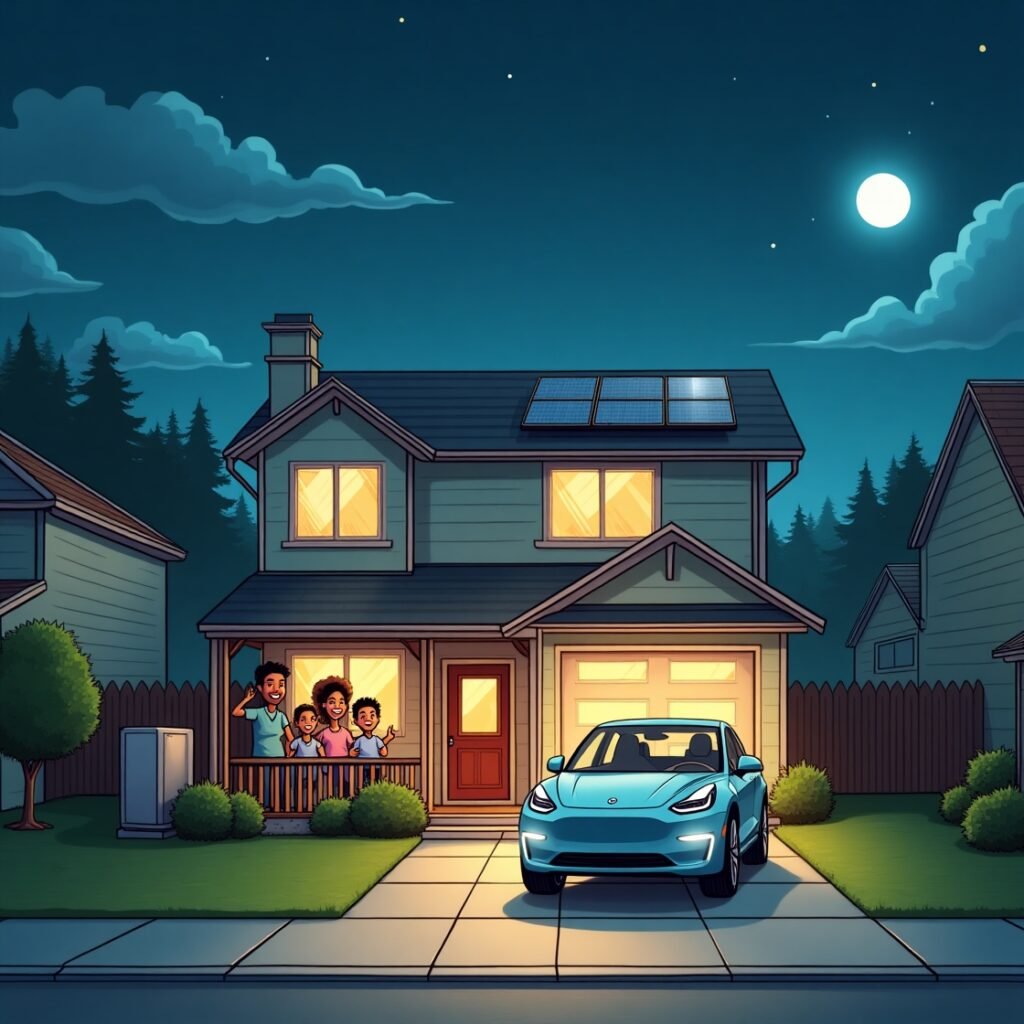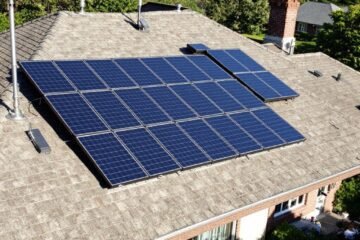
Let’s talk about the elephant in the room—or should I say, the battery in the garage? Home energy storage is blowing up faster than a TikTok trend, with installations tripling since 2020. Why? Because getting slapped with a $500 utility bill or playing “survivor” during a blackout gets old real quick.
When I first Googled “home batteries,” I felt like I’d stumbled into a NASA control room. kWh? Inverters? Peak shaving? Cue me frantically texting my engineer cousin: “IS THIS A SCAM?!” Fast-forward to last summer’s heatwave: My grid crashed, but my new battery kept the AC blasting and the margarita machine humming. (Priorities, people.)
In this guide, I’ll spill the tea on home energy storage for beginners—no jargon, just hard-won lessons from my own “why is it beeping?!” panic moments. We’ll cover:
- How to avoid my $1,200 wiring mistake
- Why “peak shaving” has nothing to do with razors (but everything to do with your wallet)
- The quick-start checklist I wish I’d had before buying
Spoiler: You don’t need a PhD in electrical engineering. Just a garage (or basement), a mild distrust of the grid, and a craving for control. Let’s turn you from a powerless ratepayer into a battery boss. 🔋
1. What Is Home Energy Storage? (And Why It’s a Game-Changer)
Alright, let’s start with the basics—because I wish someone had explained this to me before I spent two hours Googling “how do home batteries even work?” while nibbling stress-cookies during a blackout.
Picture your home’s energy storage system like a giant, high-tech pantry. Instead of stocking canned soup, you’re storing electricity. When the grid’s humming along (and rates are cheap), you fill your “pantry” with power. When prices spike or the lights go out? You raid those shelves. Simple, right? But here’s where it gets cool: This isn’t your grandpa’s generator. No fumes, no roaring engine—just silent, clean energy ready to kick in faster than you can say, “Where’s the flashlight?”
I’ll never forget the first time my battery system saved my bacon. A storm knocked out power for 18 hours, and while my neighbors were BBQing their thawing steaks in the driveway, my fridge stayed cold, the Wi-Fi stayed on, and I binge-watched The Office like it was a Tuesday. That’s the magic of home energy storage: It turns you from a passive grid customer into a boss who’s got backup.
Here’s where I tripped up early on: I thought storage was only for solar folks. Nope! Even without panels, you can stockpile cheap off-peak energy (like overnight) and use it during pricey peak hours. My buddy Dave reduced his electric bill by 40% this way—no solar required.
But why’s this such a game-changer? Let me count the ways:
- Blackout armor: When Texas froze in 2021, my system kept my heat running for 2 days. Meanwhile, my brother-in-law burned candles for light and literally melted snow for flushing toilets.
- Peak rate revenge: My utility jacks up rates from 4-9 PM. Now, I let my battery cover those hours. Last July, I saved $120. Not bad for a system that basically runs itself.
- Solar’s BFF: Without storage, excess solar energy gets sold back to the grid for pennies. With storage? You keep that gold and use it at night.
Oh, and let’s talk planet perks. My system’s saved 3 tons of CO2 in three years—equivalent to not driving 7,000 miles. But here’s the real kicker: Modern batteries last 10-15 years, require zero maintenance (unlike my lawnmower), and most come with apps so slick you’ll geek out on your energy data.
A word of caution: Not all systems are created equal. My first “budget” battery had the lifespan of a mayfly and died two weeks post-warranty. Lesson? Spring for quality. Lithium-ion costs more upfront, but it’s like buying a Honda vs. a clunker that dies in a year.
Still on the fence? Think of it this way: Home energy storage is insurance you can actually use before disaster strikes. No more praying the grid holds up during heatwaves or polar vortexes. You’re in control—and nowadays, that’s not just smart. It’s sanity-saving.
2. Top 5 Benefits of Home Energy Storage Systems
Let’s cut to the chase: I didn’t buy my home battery system to save the planet (though that’s a nice bonus). I bought it because I was done watching my utility bill climb faster than my kid on a sugar rush. But holy spreadsheet, Batman—the perks of energy storage go way beyond cash savings. Here are the five benefits that made me a total battery evangelist, complete with my “why didn’t I do this sooner?” facepalms.
1. Slash Your Bills with Peak Shaving (aka Outsmarting Your Utility)
Peak hours are a racket. My utility charges triple from 4-9 PM, which is exactly when I’m running AC, cooking, and binge-watching Netflix. Enter my battery’s “peak shaving” mode. It automatically powers my house during those pricey hours using stored cheap energy. Last summer, I saved $90/month—enough for a fancy coffee habit. Pro tip: Pair this with time-of-use rates, and you’re basically printing money.
2. Blackout? What Blackout?
During the Great Texas Freeze of 2021, my neighbors were huddling in cars to stay warm. Meanwhile, my battery kept the heat running for 36 hours straight. I hosted a “disaster pizza party” for three frozen families, powering my oven and Wi-Fi like a humble superhero. True story: My friend’s CPAP machine stayed on all night, and she cried relief tears into her coffee the next morning.
Lesson learned: Size matters. My first 10 kWh system couldn’t handle heating and cooking. Upgrading to 19 kWh meant I could stop rationing outlets like the last roll of TP in 2020.
3. Solar’s Missing Puzzle Piece
Without storage, my solar panels were like a bakery that closes at 3 PM—useless when I actually needed fresh bread (or electricity). Selling excess solar to the grid earned me a measly 4¢/kWh, but storing it for night use saved me 15¢/kWh. Cha-ching! Now, my nighttime Netflix runs on sunshine I harvested at noon.
4. Your Home’s Now a (Quiet) Fortress
Generators? Please. My old gas guzzler sounded like a lawnmower convention and reeked worse than a gym bag. My battery kicks in silently in 0.2 seconds—so fast, I often don’t notice the grid’s down. Plus, no fumes mean I can stash it in the garage without gaslighting myself (literally).
Bonus perk: My home insurance dropped 12% because insurers love fire-safe lithium batteries more than explosion-prone generators.
5. You’re Basically Future-Proofing
When I installed my system, EVs were “someday” dreams. Now that I drive one, my battery charges it overnight using off-peak rates, saving another $50/month. Plus, energy storage boosts resale value—a 2023 study found homes with batteries sell 4.2% faster. Take that, stainless-steel appliances.
But a warning: Future-proofing isn’t free. I skipped critical wiring upgrades during installation, then paid $2k later to support my EV charger. Do it right the first time.
The Real Tea
Home energy storage isn’t just about batteries—it’s about taking back control. No more groveling to the grid or sweating through rate hikes. And hey, if my climate-conscious teen is happy we’ve cut our carbon footprint by 1.2 tons/year? Icing on the cake.
Still skeptical? Do what I did: Visit a friend’s home during an outage to see their system in action. After watching their fridge stay cold, lights stay on, and Wi-Fi stay online instead of flatlining, you’ll be Googling installers faster than I can say ‘tax credit.”

3. How Home Battery Systems Work: A Beginner-Friendly Breakdown
Now, let’s break down the nuts and bolts. Every system has four main parts:
The Basic Recipe: 4 Ingredients
- The Battery: Usually lithium-ion (like your phone, but the size of a mini-fridge).
- The Inverter: A translator that turns battery DC power into AC power your house can use.
- The Charge Controller: The “battery bodyguard.” It regulates incoming power to prevent overcharging (think of it as the bouncer that keeps your battery from getting fried by solar panels or the grid).
- The Software: The brain that manages energy flow. Decides when to store, use, or sell energy.
Here’s how they team up: When your solar panels pump out extra energy at noon, the charge controller ensures the battery charges safely, while the software says, “Hey, let’s stash this in the battery instead of selling it for pennies!” At night, when the grid’s pricier, the inverter flips the switch: “Unleash the stored juice!”
Pro tip: Charge controllers are especially critical for solar setups. My first DIY system skipped one, and my battery swelled up like a watermelon in July. $1000 mistake and VERY dangerous.
AC vs. DC Coupling: Why It Matters
- DC-coupled systems (common with solar setups) send solar energy straight to the battery as DC. Less energy lost, cheaper to install.
- AC-coupled systems convert solar energy to AC first, then back to DC for storage. Slightly less efficient, but way more flexible if you’re retrofitting an older home.
I learned this the hard way. My solar installer pushed a DC system, but my 1980s wiring couldn’t handle it (didn’t have modern electrical panel, DC-rated conduit, or code-compliant grounding). Swapped to AC-coupled, ate a $1,200 fee, and cried into my utility bill.
The Silent Hero: Surge Capacity
Your battery system’s inverter surge capacity is like a sprinter’s explosive power—it needs to handle short bursts when appliances kick on. My neighbor’s system failed because her AC’s startup surge (a whopping 5,000 watts!) exceeded her inverter’s max. Check your appliance manuals for surge watts.
My rule of thumb: Size your battery system’s inverter surge capacity to 1.5x your biggest appliance’s startup draw.
Software: The Real MVP
Modern systems use AI to predict weather, energy prices, and your habits. Mine knows I crank the AC every Saturday at 2 PM (laundry day, don’t judge) and pre-charges the battery accordingly. But here’s the kicker: If your utility offers “demand response” programs, your battery can earn you money by feeding power back during grid stress. Cha-ching!
Battery Chemistry 101
- Lithium-ion: Lightweight, 10-15 year lifespan, 95% efficient. Costs more upfront.
- Lead-acid: Cheap, but bulky, 5-7 year lifespan, 80% efficient. Perfect for off-grid cabins, not suburban homes.
I made the rookie mistake of buying a used lead-acid battery for my shed. It died after two winters. Lesson: Lithium’s worth the splurge.
The Grid’s Role (It’s Not the Enemy)
Your system isn’t off-grid—it’s grid-hybrid. When the battery’s low, the grid fills in. When it’s full, you sell excess. Think of it like a dance partner, not a divorce.
One Last Thing: Safety
Batteries get cranky if they’re too hot or cold. Mine lives in the garage (55-90°F is the sweet spot). And for the love of outlet covers, don’t stack boxes on it.
The Takeaway
Home battery systems aren’t magic—they’re just smart engineering. Once you grasp the basics (and avoid my blunders), you’ll realize it’s less about tech jargon and more about peace of mind. Still confused? Ask your installer to walk you through a live demo. If they can’t explain it without acronyms, find one who speaks human.
4. Choosing the Right Home Energy Storage System
Let me tell you, picking a home battery system is like dating—you don’t want to commit to the first shiny option that winks at you. I learned this the hard way when I impulse-bought a “bargain” battery during a Black Friday sale. Spoiler: It couldn’t power my coffee maker, let alone my fridge during an outage. Total facepalm moment.
First, figure out your “why.” Are you storing solar energy? Prepping for blackouts? Or just trying to dodge those 4 PM peak rates? For me, it was all three—I wanted backup power for storms and to stop overpaying my utility company. But here’s where I messed up: I didn’t calculate my actual energy needs. My tiny 5 kWh system (cheap!) couldn’t handle my fridge (1-2 kWh/day) and my internet addiction. After a 12-hour blackout left me eating lukewarm canned beans, I upgraded to a 19 kWh LG Chem RESU. Lesson learned: Start with a kWh audit.
Grab your last 12 utility bills, find your average daily usage, then subtract what your solar panels cover (if you have them). For most beginners, 10-15 kWh is the sweet spot. But don’t forget surge loads! My neighbor’s system tripped because her AC startup surge was 3x the inverter’s max output.
Brands matter, but don’t get starstruck. I drooled over Tesla’s sleek design but ended up with an LG Chem RESU because it paired better with my older solar inverter. Compatibility is everything. Some systems only play nice with specific inverters—like trying to pair an iPhone with a 1990s printer. Check your solar setup’s specs (voltage, AC/DC coupling) before swiping that credit card.
Budget-wise, prepare for sticker shock. My first quote was $15k (before incentives), and I almost choked on my kombucha. But here’s the hack: Tax credits and rebates are your BFF. The Inflation Reduction Act slashes 30% off your cost if you pair storage with solar. My state tossed in another $1k, and my utility company offered a “demand response” rebate for letting them borrow my battery during peak times. Cha-ching!
Avoid my “bargain bin” mistake. Cheap lead-acid batteries? They’re like Tamagotchis—high maintenance and short-lived. Lithium-ion costs more upfront but lasts 10+ years with zero babysitting. And skip DIY installs unless you’re a licensed electrician. I watched a YouTube tutorial and almost welded my toolbox to the garage wall.
One pro tip: Size for tomorrow, not today. When I installed my system, I didn’t own an EV. Now that I do? My battery’s crying uncle every time I charge. Future-proof by adding 20-30% extra capacity.
Bottom line: Your perfect system isn’t about specs—it’s about your life. Work with a local installer who asks you questions, not just their sales script. And if you take one thing from my caffeine-deprived blackout trauma, let it be this: Bigger isn’t always better, but undersizing is a one-way ticket to Beanageddon.
5. Installation and Maintenance: What First-Time Owners Need to Know
Let me paint you a picture: It’s 8 PM on a Friday. I’m standing in my garage, covered in drywall dust, staring at a 300-pound battery that’s supposed to be mounted on the wall. My DIY ego? Shattered. My partner? Laughing so hard they’re filming me for TikTok. Moral of the story: Home energy storage isn’t IKEA furniture. Here’s what I wish I’d known before playing Bob the Builder with my backup power.
Installation: Leave It to the Pros (Seriously)
I get it—you want to save money. But unless you’re a licensed electrician with a death wish, hire a certified installer. My “I’ll just YouTube it” moment cost me $500 in botched wiring repairs. Here’s why pros matter:
- Permits: Most areas require them, and inspectors will check. My town fined a neighbor $1k for skipping this step.
- Load calculations: Your electrical panel might need upgrades. Mine was older than my high school prom dress and couldn’t handle the new system.
- Safety: Lithium-ion batteries don’t play nice with water, heat, or amateur mistakes. Fun fact: They can combust if installed near gas lines (ask me how I know).
Pro tip: Get 3 quotes. My first installer tried to upsell me on a “premium ventilation system” that was just a $20 fan.
Where to Put the Darn Thing
Batteries aren’t picky, but they hate extremes. Ideal spots:
- Garage: Easy access, stable temps. Just don’t park your car too close (I dented mine backing into the battery).
- Basement: Cool and dry, but avoid areas prone to flooding.
- Outdoors: Only if rated for weather. My buddy’s system got snowdrifted in Minnesota and went into “hibernation mode” for a week.
Maintenance: Less Work Than a Goldfish
Good news: Modern systems are mostly “set and forget.” Bad news: “Mostly” isn’t “always.” Here’s your cheat sheet:
- Software updates: Do them. Skipping one caused my system to ignore peak rates for a month.
- Monthly checkup: Open the app. Is it charging/discharging normally? Any error codes? (Mine once flashed “BMS ERROR P0A10” Turns out it meant “clean the dust off my vents.”)
- Annual pro inspection: Like a physical for your battery. Costs $150-$300, but catches issues like corroded terminals or fading capacity.
Lifespan hack: Avoid deep discharges. I drained my battery to 5% daily “to max savings,” and its capacity dropped 15% in two years. Now I never go below 20%.
Winter & Summer Survival Guide
- Cold climates: Batteries lose efficiency below freezing. Mine once dropped to 60% capacity during a -10°F snap. Solution: Insulate the space or opt for a cold-rated model.
- Heatwaves: Keep it below 90°F. I added a $50 vent fan to my garage during a Phoenix summer, and performance improved 20%.
Warranty Fine Print: Read It
Most batteries have 10-year warranties, but loopholes exist. My warranty voided because I’d installed it on an unapproved wall material (apparently, cinder blocks aren’t “romantic” enough). Key questions to ask:
- Does it cover capacity degradation? (Mine didn’t.)
- What voids it? (Hint: DIY repairs, water damage, or acts of “curious pets.”)
The “Oh Crap” Moment Plan
Even the best systems hiccup. Here’s your emergency kit:
- Installer’s phone number (not buried in your email).
- Error code cheat sheet (print it—Wi-Fi might be down).
- Backup backup: A small portable battery for critical devices.
Final Takeaway
Home energy storage is a marathon, not a sprint. Invest in a quality install, treat the system like a high-maintenance houseplant (but less needy), and please don’t stack holiday decorations on it like I did. Follow these steps, and you’ll avoid 90% of my facepalm moments. And hey, if all else fails? At least you’ll have power while you Google “how to fix error code BMS_ERR BMS000004.”
Conclusion
Let’s be real—home energy storage isn’t just for Elon Musk stans or folks who brew their own kombucha. It’s for anyone who’s ever glared at a utility bill like it just keyed their car. After surviving blackouts, botched DIY installs, and a truly tragic “no coffee” morning, here’s what I know: These systems aren’t a luxury anymore. They’re a middle finger to rising rates and a high-five to peace of mind.
You’ve got the basics down now: how batteries work, why surge capacity matters, and how to avoid my “stacking paint cans next to the inverter” blunder. Imagine never begging your neighbor to charge your phone during a storm—or better yet, being the neighbor who powers the block’s pizza party.
Here’s your homework (don’t worry, no pop quiz):
- Stalk local installers’ reviews like you’re picking a Netflix show.
- Raid the Inflation Reduction Act’s rebates—it’s basically free money.
- Talk to someone who owns a system. (Pro tip: Bribe them with cookies. Works every time.)
You don’t need to go full “off-grid hermit” overnight. Start with a small battery to power essentials, then scale up when you’re ready to say goodbye to peak rates for good. And hey, if my system can survive a Texas freeze, a curious Labrador, and my own questionable wiring choices? Yours’ll do just fine.
The best part? Every kilowatt you store is a win for your wallet and the planet. Now go forth, harness that energy freedom—and maybe send me a thank-you postcard from the future. (I accept cookies, too.) 🍪🔋



